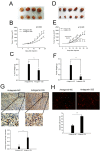Targeting oncogenic miR-335 inhibits growth and invasion of malignant astrocytoma cells
- PMID: 21592405
- PMCID: PMC3129318
- DOI: 10.1186/1476-4598-10-59
Targeting oncogenic miR-335 inhibits growth and invasion of malignant astrocytoma cells
Abstract
Background: Astrocytomas are the most common and aggressive brain tumors characterized by their highly invasive growth. Gain of chromosome 7 with a hot spot at 7q32 appears to be the most prominent aberration in astrocytoma. Previously reports have shown that microRNA-335 (miR-335) resided on chromosome 7q32 is deregulated in many cancers; however, the biological function of miR-335 in astrocytoma has yet to be elucidated.
Results: We report that miR-335 acts as a tumor promoter in conferring tumorigenic features such as growth and invasion on malignant astrocytoma. The miR-335 level is highly elevated in C6 astrocytoma cells and human malignant astrocytomas. Ectopic expression of miR-335 in C6 cells dramatically enhances cell viability, colony-forming ability and invasiveness. Conversely, delivery of antagonist specific for miR-335 (antagomir-335) to C6 cells results in growth arrest, cell apoptosis, invasion repression and marked regression of astrocytoma xenografts. Further investigation reveals that miR-335 targets disheveled-associated activator of morphogenesis 1(Daam1) at posttranscriptional level. Moreover, silencing of endogenous Daam1 (siDaam1) could mimic the oncogenic effects of miR-335 and reverse the growth arrest, proapoptotic and invasion repression effects induced by antagomir-335. Notably, the oncogenic effects of miR-335 and siDAAM1 together with anti-tumor effects of antagomir-335 are also confirmed in human astrocytoma U87-MG cells.
Conclusion: These findings suggest an oncogenic role of miR-335 and shed new lights on the therapy of malignant astrocytomas by targeting miR-335.
Figures









References
Publication types
MeSH terms
Substances
LinkOut - more resources
Full Text Sources
Other Literature Sources

